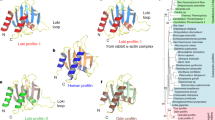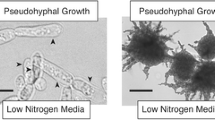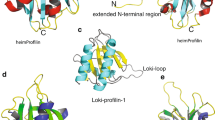Summary
Profilin is a ubiquitous actin-monomer-binding protein. The protistPhysarum polycephalum contains two profilins, ProA and ProP, present in amoebae and plasmodia, respectively. We have used mutantSaccharomyces cerevisiae cells in an attempt to observe distinct functions for the two profilins. Profilin-deficient yeast cells (Δpfy1) have delocalized actin cortical patches, do not contain visible actin cables, have reduced mating efficiency and do not grow at 37 °C or in the presence of caffeine. Deletion of theSRV2 gene (Δsrv2), coding for the adenylyl cyclase-associated protein, also results in an altered actin distribution and an inability to survive on rich medium. We found that the Δpfy1 and Δsrv2 mutant phenotypes were corrected equally well by the overexpression of Physarum ProA or yeast Pfy1p profilins. The Δpfy1 cells overexpressing ProP have improved mating efficiency and a normal distribution of actin cortical patches. These cells, however, have barely detectable actin cables, do not grow at 37 °C, and are sensitive to caffeine. Also, the expression of ProP does not correct the growth defect of the Δsrv2 cells. These results suggest that the two Physarum proteins are not functionally equivalent in yeast cells. No difference was detected in the affinity of ProA and ProP for poly-L-proline, while ProA has a slightly greater affinity than ProP for phosphatidylinositol 4,5-biphosphate.
Similar content being viewed by others
Abbreviations
- FITC:
-
tfluorescein isothiocyanate
- PIP2 :
-
phosphatidylinositol 4,5-biphosphate
- YPD:
-
yeast extract peptone dextrose
References
Adams AE, Pringle JR (1991) Staining of actin with fluorochrome-conjugated phalloidin. Methods Enzymol 194: 729–731
Ampe C, Vandekerckhove J, Brenner SL, Tobacman L, Korn ED (1985) The amino acid sequence ofAcanthamoeba profllin. J Biol Chem 260: 834–840
Becker DM, Guarente L (1991) High-efficiency transformation of yeast by electroporation. Methods Enzymol 194: 182–187
Binette F, Benard M, Laroche A, Pierron G, Lemieux G, Pallotta D (1990) Cell-specific expression of a profllin gene family. DNA Cell Biol 9: 323–334
Cao LG, Babcock GG, Rubenstein PA, Wang YL (1992) Effects of profilin and profilactin on actin structure and function in living cells. J Cell Biol 117: 1023–1029
Christensen HEM, Ramachandran S, Tan CT, Surana U, Dong CH, Chua NH (1996)Arabidopsis profilins are functionally similar to yeast profilins: identification of a vascular bundle-specific profilin and a pollen-specific profilin. Plant J 10: 269–279
Evangelista M, Blundell K, Longtine M, Chow C, Adames N, Pringle J, Peter M, Boone C (1997) Bni1p, a yeast formin linking Cdc42p and the actin cytoskeleton during polarized morphogenesis. Science 276: 118–122
Field J, Vojtek A, Ballester R, Bolger G, Colicelli J, Ferguson K, Gerst J, Kataoka T, Michaeli T, Powers S, Riggs M, Rodgers L, Wieland I, Wheland B, Wigler M (1990) Cloning and characterization of CAP, the S.cerevisiae gene encoding the 70 kd adenylyl cyclase-associated protein. Cell 61: 319–327
Gerst JE, Ferguson K, Vojtek A, Wigler M, Field J (1991) CAP is a bifunctional component of theSaccharomyces cerevisiae adenylyl cyclase complex. Mol Cell Biol 11: 1248–1257
Gertler FB, Niebuhr K, Reinhard M, Wehland J, Soriano P (1996) Mena, a relative of VASP andDrosophila Enabled, is implicated in the control of microfilament dynamics. Cell 87: 227–239
Goldschmidt-Clermont PJ, Machesky LM, Baldassare JJ, Pollard TD (1990) The actin-binding protein profilin binds to PIP2 and inhibits its hydrolysis by phospholipase C. Science 247: 1575–1578
Haarer BK, Lillie SH, Adams AE, Magdolen V, Bandlow W, Brown SS (1990) Purification of profilin fromSaccharomyces cerevisiae and analysis of profilin-deficient cells. J Cell Biol 110: 105–114
—, Petzold AS, Brown SS (1993) Mutational analysis of yeast profilin. Mol Cell Biol 13: 7864–7873
Haugwitz M, Noegel AA, Rieger D, Lottspeich F, Schleicher M (1991)Dictyostelium discoideum contains two profilin isoforms that differ in structure and function. J Cell Sci 100: 481–489
Honore B, Madsen P, Andersen AH, Leffers H (1993) Cloning and expression of a novel human profilin variant, profilin II. FEBS Lett 330: 151–155
Imamura H, Tanaka K, Hihara T, Umikawa M, Kamei T, Takahashi K, Sasaki T, Takai Y (1997) Bni1p and Bnr1p: downstream targets of the Rho family small G-proteins which interact with profilin and regulate actin cytoskeleton inSaccharomyces cerevisiae. EMBO J 16: 2745–2755
Kaiser C, Michaelis S, Mitchell A (1994) Modified lithium acetate yeast transformation. In: Adams A, Gottschling DE, Kaiser C, Stearns T, Methods in yeast genetics. Cold Spring Harbor Laboratory Press, Cold Spring Harbor, NY, pp 201–202
Kaiser DA, Sato M, Ebert RF, Pollard TD (1986) Purification and characterization of two isoforms ofAcanthamoeba profilin. J Cell Biol 102: 221–226
Karpova TS, McNally JG, Moltz SL, Cooper JA (1998) Assembly and function of the actin cytoskeleton of yeast: relationships between cables and patches. J Cell Biol 142: 1501–1517
Kwiatkowski DJ, Bruns GA (1988) Human profilin: molecular cloning, sequence comparison, and chromosomal analysis. J Biol Chem 263: 5910–5915
Lambrechts A, van Damme J, Goethals M, Vandekerckhove J, Ampe C (1995) Purification and characterization of bovine profilin II: actin, poly(L-proline) and inositolphospholipid binding. Eur J Biochem 230: 281–286
—, Verscheide J, Jonckheere V, Goethals M, Vandekerckhove J, Ampe C (1997) The mammalian profilin isoforms display complementary affinities for PIP2 and proline-rich sequences. EMBO J 16: 484–494
Lassing I, Lindberg U (1985) Specific interaction between phosphatidylinositol 4,5-bisphosphate and profilactin. Nature 314: 472–474
Lew DJ, Reed SI (1995) Cell cycle control of morphogenesis in budding yeast. Curr Opin Genet Dev 5: 17–23
Lindberg U, Schutt CE, Hellsten E, Tjader AC, Hult T (1988) The use of poly(L-proline)-Sepharose in the isolation of profilin and profilactin complexes. Biochim Biophys Acta 967: 391–400
Machesky LM, Goldschmidt-Clermont PJ, Pollard TD (1990) The affinities of human platelet andAcanthamoeba profilin isoforms for polyphosphoinositides account for their relative abilities to inhibit phospholipase C. Cell Regul 1: 937–950
Marcoux N, Bourbonnais Y, Charest PM, Pallotta D (1998) Over-expression ofMID2 suppresses the profilin-deficient phenotype of yeast cells. Mol Microbiol 29: 515–526
Metzler WJ, Bell AJ, Ernst E, Lavoie TB, Mueller L (1994) Identification of the poly-L-proline-binding site on human profilin. J Biol Chem 269: 4620–4625
Pruyne DW, Schott DH, Bretscher A (1998) Tropomyosin-containing actin cables direct the Myo2p-dependent polarized delivery of secretory vesicles in budding yeast. J Cell Biol 143: 1931–1945
Reinhard M, Giehl K, Abel K, Haffner C, Jarchau T, Hoppe V, Jockusch BM, Walter U (1995) The proline-rich focal adhesion and microfilament protein VASP is a ligand for profilins. EMBO J 14: 1583–1589
Rosenberg AH, Lade BN, Chui DS, Lin SW, Dunn JJ, Studier FW (1987) Vectors for selective expression of cloned DNAs by T7 RNA polymerase. Gene 56: 125–135
Schlüter K, Jockusch BM, Rothkegel M (1997) Profilins as regulators of actin dynamics. Biochim Biophys Acta 1359: 97–109
Studier FW, Moffatt BA (1986) Use of bacteriophage T7 RNA polymerase to direct selective high-level expression of cloned genes. J Mol Biol 189: 113–130
Tabor S, Richardson CC (1985) A bacteriophage T7 RNA polymerase/promoter system for controlled exclusive expression of specific genes. Proc Natl Acad Sci USA 82: 1074–1078
Theriot JA, Rosenblatt J, Portnoy DA, Goldschmidt-Clermont PJ, Mitchison TJ (1994) Involvement of profilin in the actin-based motility ofL. monocytogenes in cells and in cell-free extracts. Cell 76: 505–517
Vernet T, Dignard D, Thomas DY (1987) A family of yeast expression vectors containing the phage f1 intergenic region. Gene 52: 225–233
Vojtek A, Haarer B, Field J, Gerst J, Pollard TD, Brown S, Wigler M (1991) Evidence for a functional link between profilin and CAP in the yeastS. cerevisiae. Cell 66: 497–505
Yeh J, Haarer BK (1996) Profilin is required for the normal timing of actin polymerization in response to thermal stress. FEBS Lett 398: 303–307
Author information
Authors and Affiliations
Rights and permissions
About this article
Cite this article
Marcoux, N., Laforest, M. & Pallotta, D. The twoPhysarum polycephalum profiling are not functionally equivalent in yeast cells. Protoplasma 210, 45–51 (1999). https://doi.org/10.1007/BF01314954
Received:
Accepted:
Issue Date:
DOI: https://doi.org/10.1007/BF01314954




